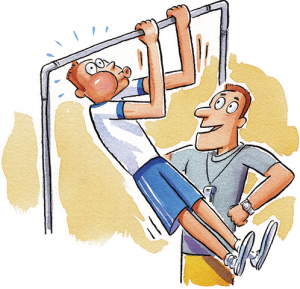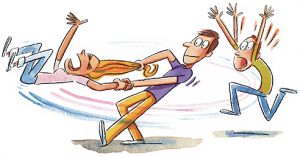100-Percent-Cotton Glory
By Clarissa Whetten Haycock (’10), Ontario, Calif.
When my husband’s indoor soccer team became intramural champions, I began breaking the commandment printed on the back of his champion’s T-shirt: “Thou Shalt Not Covet.” I joined soccer, softball, volleyball, kickball, and even inner tube water polo teams with hopes of earning the shirt. After striking out each time, I decided to go solo and signed up for the 150-mile run, which had to be accomplished within two-and-a-half months.
I began with the best of intentions and spent many cold mornings running myself dizzy around the Smith Fieldhouse’s indoor track. But just before the deadline I discovered in horror that I had 22 miles left to cover by 4 p.m. the next day. With dread and determination I went to the Fieldhouse in the morning to run my heart out. But as classes began I was forced to run on only half the track and was later bumped to the treadmills. When those were occupied I had to substitute miles on a stationary bike.
I battled self-doubt and often wanted to quit. But I mustered a surge of desire to win that T-shirt and emotionally completed my last mile just minutes before the deadline. I had run a half-marathon and biked a full marathon. I hobbled over to the Intramural Office, where a worker checked my logged miles and unceremoniously handed me my cotton trophy.
Just the smell of the Smith Fieldhouse triggers emotional flashbacks of the sweat and tears shed that day to earn the most coveted shirt on campus.
15 Pounds of Fame
By Lisa Hortin Schader (BS ’09, MAcc ’09), San Jose, Calif.
My sophomore year, my roommate and I were walking between the RB and Smith Fieldhouse when a reporter approached us. She was interviewing students regarding BYU’s new distinction as Men’s Fitness magazine’s 2005 “Fittest College Campus.” The reporter mentioned her news organization, but the name didn’t register, so I figured it was some small-town paper. I freely rambled on about how I had gained “the freshman 15” (pounds) and was now working it off.
It turned out she worked for the Associated Press—the world’s largest news-gathering organization—and soon I had relatives calling me from Atlanta, Cleveland, Chicago—just to name a few—to tell me they’d read in their paper about how I had gotten fat.
Thanks to BYU’s great fitness resources, I was able to work off the freshman 15, but—perhaps more important—I learned my lesson about the power of the press.
Work the Weakness
By John M. Pawlowski (BA ’05), Omaha, Neb.
 As studly as I thought I was as a high school football player in Texas, I quickly learned that I lacked the skills, muscles, and intelligence to play at BYU. I grew content to cheer from the bleachers.
As studly as I thought I was as a high school football player in Texas, I quickly learned that I lacked the skills, muscles, and intelligence to play at BYU. I grew content to cheer from the bleachers.
However, I did not want to atrophy into an all-out wimp, so I enrolled in a weight-training class in the Smith Fieldhouse. The final would consist of five exercises, one of which was pull-ups. I could do only a few. In an attempt to show my maturity and forethought, I approached the coach mid-semester:
Me: “Coach, what exercises can I do to get better at doing pull-ups?”
Coach: “Well, you could start with pull-ups.”
Me: “No, I want to strengthen supporting muscles to get better at pull-ups. What would you recommend?”
Coach: “First, do as many pull-ups as you can. Then rest a minute or two. Then grab the bar and do as many pull-ups as you can. Repeat this 1,000 times.”
Me: “I don’t think you understand.”
Coach: “Son, you can’t fix a weakness by focusing on strengths related to the weakness. Work the weakness.”
My palms still have calluses from his class, but he was right. This impromptu lesson can be applied to all sorts of weaknesses—from weight training to public speaking to study habits—and it has stuck with me ever since.
Screaming Success
By Kathleen Pederson Whitworth (BA ’69), Valley Center, Calif.
In the late 1960s I took a theater class in the Richards Building. Among other things, we learned how to fall without getting hurt and how to choreograph fights—slapping, punching, and even swinging a girl by her hair.
The last of these looked painful, but if done correctly it was painless. The guy would grab the girl’s long hair and lift her off her feet as he swung her around. Meanwhile, the girl would shriek with pretended pain—but because she would hold onto the guy’s wrists as he grabbed her hair, all the force was directed through her arms, not her hair.
When we practiced this move in class, the room couldn’t accommodate everyone, so my partner and I headed for a wide hallway in a seemingly unoccupied section of the building.
 He grabbed my hair, and I screamed and clutched his wrists as he began spinning me. Suddenly someone was running toward us, shouting, “Stop it!”
He grabbed my hair, and I screamed and clutched his wrists as he began spinning me. Suddenly someone was running toward us, shouting, “Stop it!”
We stopped and glanced at each other. Were we not allowed in that part of the building?
The shouter drew closer, glaring at my partner. Then he turned to me. “Are you all right?” He’d come to rescue me.
I smiled. “I’m fine. We’re just rehearsing for a drama class.”
The young man rolled his eyes and turned away, mumbling something about “theater people.”
My partner and I were ecstatic. What we had done felt fake, but it looked real—and that was the whole point.
32 Hours in the Pool
By Susan Troub Birrell (BS ’74), Fruit Heights, Utah
In 1973 I signed on to help a student body officer come up with ideas for world records BYU students could break. While perusing the Guinness Book of World Records, I saw that the record for treading water was 16 hours. How hard could that be to break?
I contacted the Guinness people in England and set up volunteers to observe us in the Richards Building diving pool. Shortly before our planned attempt, I received word that a new record had been set—24 hours.
Twenty-four of us began at 10 on a Thursday night. On Friday my health teacher supported me by bringing the class to the pool for part of the lecture, my visiting teachers presented a poolside message, and children dove and splashed around during the family swim hours. At 10 p.m. on Friday night, eight of us were left in the pool. We had already broken the world record, but half of us decided to keep at it. We four remaining water treaders decided it wouldn’t be right for only one to win: we all touched the side of the pool at 6 a.m. on Saturday, Nov. 17, 1973, setting a new world record of 32 hours.
Tights?
By Karl J. Fields (BA ’83), Gig Harbor, Wash.
A recently returned missionary and Idaho cowboy, I arrived on campus in 1979 and had much to learn about the BYU social scene. At the advice of a former missionary companion, I had dutifully enrolled in a dance class, a surefire way to meet plenty of girls.
With no dancing experience, I entered the RB that first morning with some trepidation. I was puzzled by the small size of the classroom and the floor-to-ceiling mirrors. My unease increased as the instructor took roll: seven women and me.
But the final straw came as the instructor explained that we should come to Thursday’s class ready to dance . . . in our tights. With that, I executed the only dance move I knew, fading into the curtains and exiting the room.
When I related the experience to my former companion, he asked what course I had signed up for. I explained I had registered for modern dance, thinking I would have better success on the dance floor if I learned the most modern steps. The class I should have signed up for was ballroom dance!









